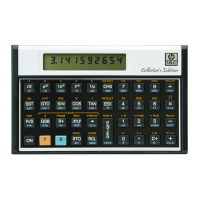Section 3: The Memory Stack, LAST X, and Data Storage 43
The above are stack lift-enabling operations, so the number remaining in
the X-register can be used for subsequent calculations. If you address a
nonexistent register, the display will show
Error 3
.
Example: Springtime is coming and you want to keep track of 24 crocuses
planted in your garden. Store the number of crocuses blooming the first
day and add to this the number of new blooms the second day.
Keystrokes Display
3 O 0
3.0000
Stores the number of first-day
blooms in R
0
.
Turn the calculator off. Next day, turn it back on again.
l 0
3.0000
Recalls the number of crocuses
that bloomed yesterday.
5 +
8.0000
Adds today’s new blooms to get
the total blooming crocuses.
Clearing Data Storage Registers
Pressing ´ CLEAR Q (clear registers) clears the contents of all
data storage registers to zero. (It does not affect the stack or the LAST X
register.) To clear a single data storage register, store zero in that
register. Resetting Continuous Memory clears all registers and the stack.
Storage and Recall Arithmetic
Storage Arithmetic. Suppose you not only wanted to store a number, but
perform arithmetic with it and store the result in the same register. You
can do this directly—without using l—by using the following
procedure.
1. Have your second operand (besides the one in storage) in the
display (as the result of a calculation, a recall, or keying in).
2. Press O.
3. Press +, -, *, or ÷.
4. Key in the register address (0 to 9, .0 to .9). (The Index register,
discussed in Section 10, can also be used.)

